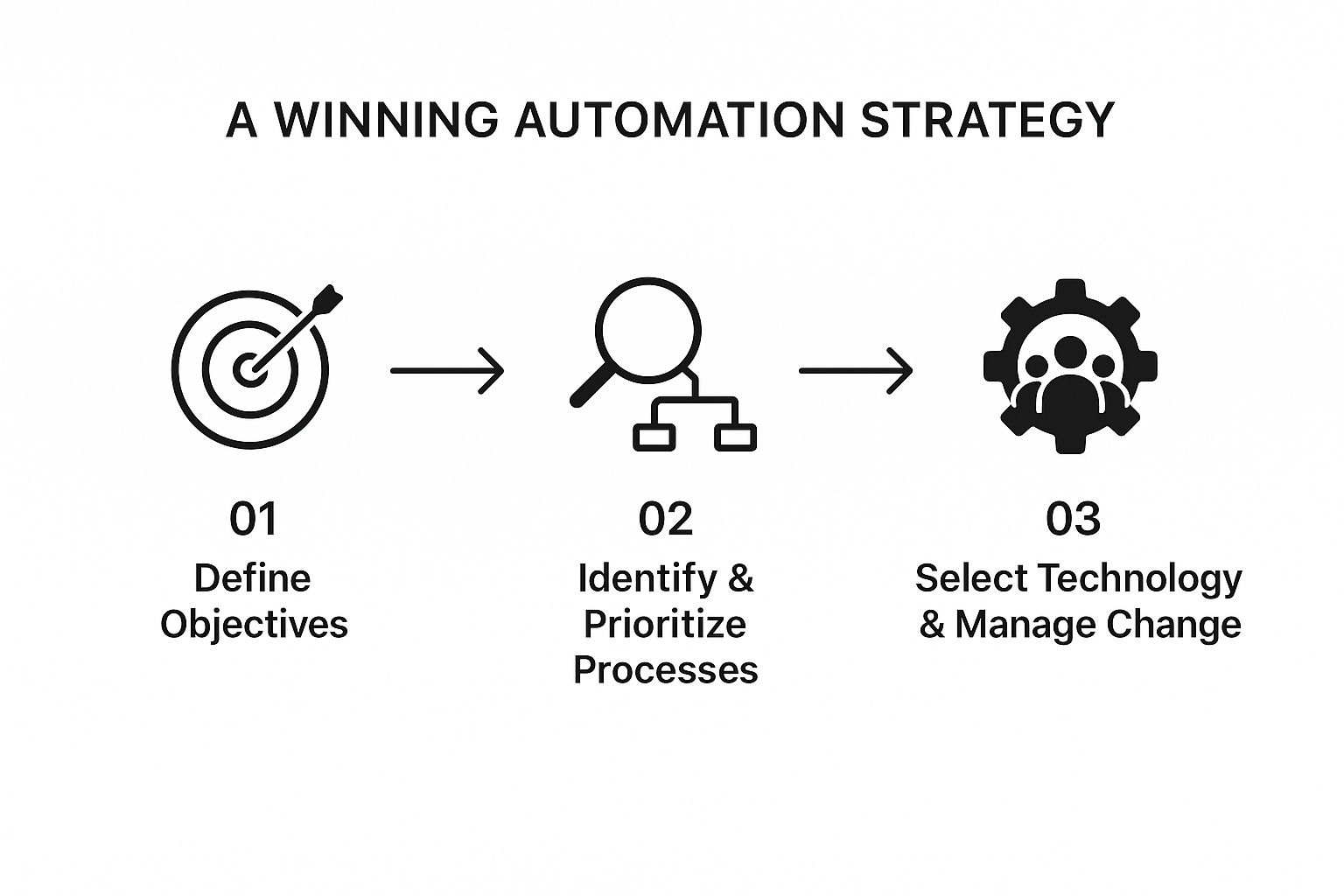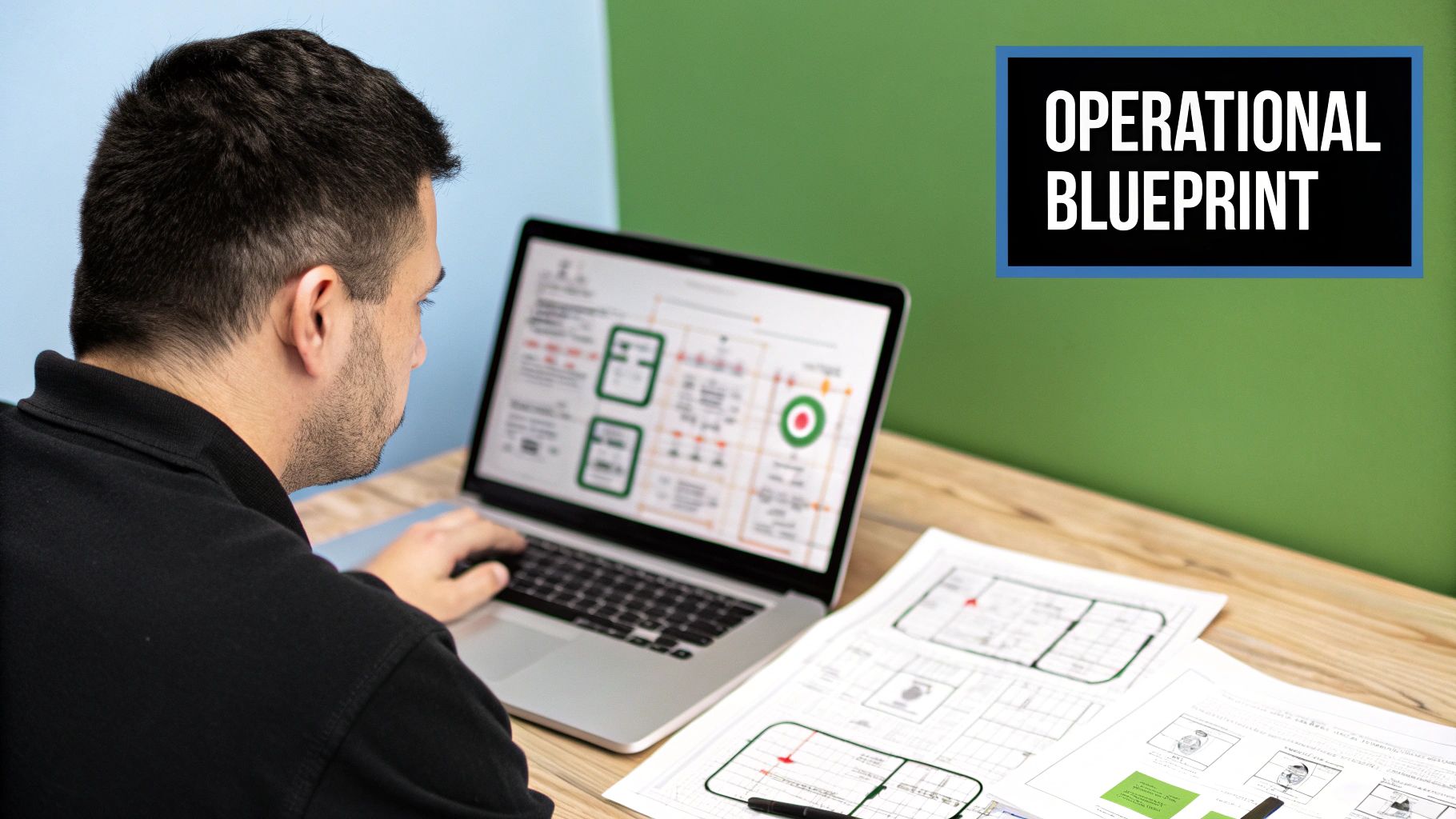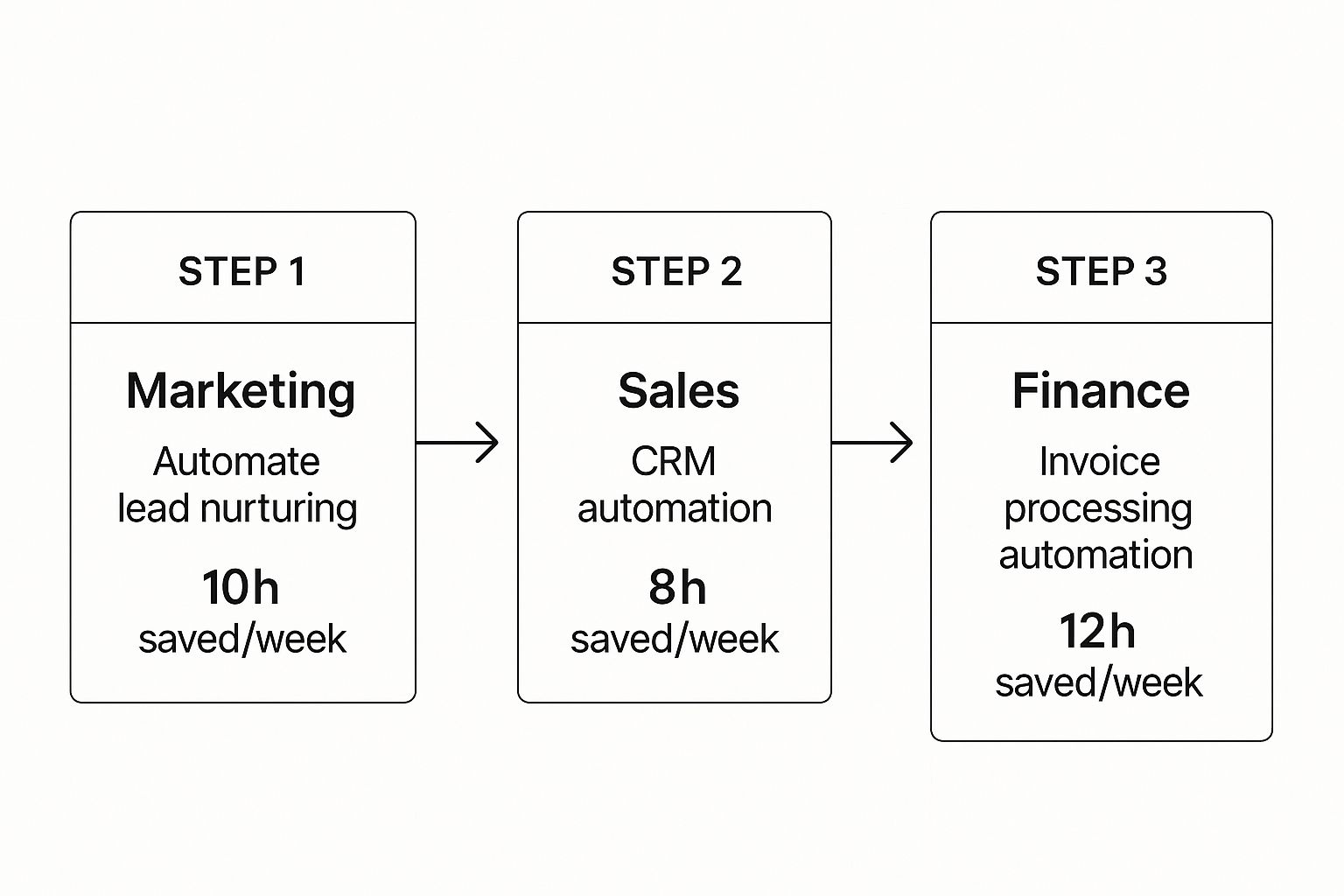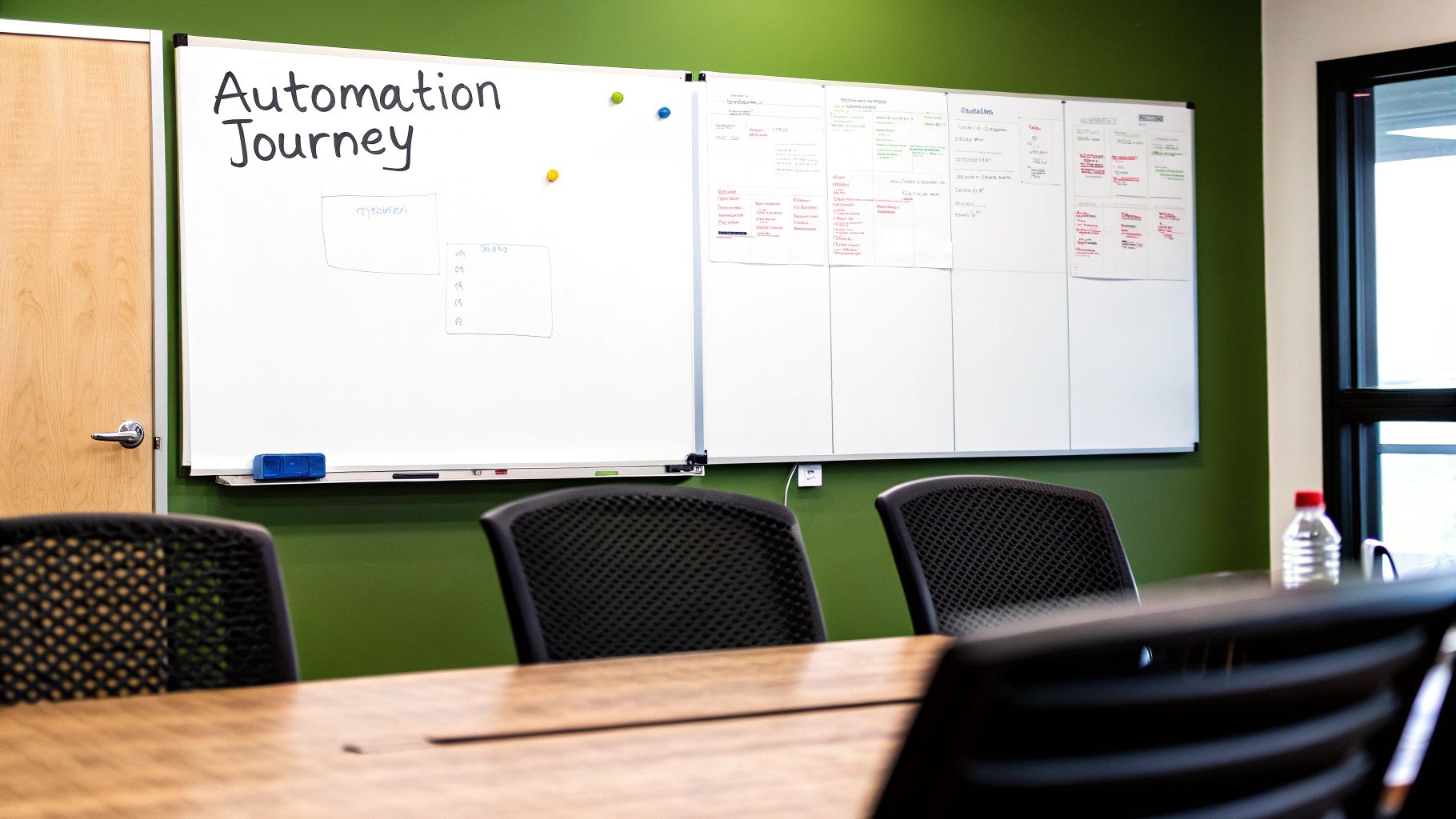- Oct 16
- 17 min read
A business process automation strategy is your company's official game plan for using technology to make workflows run on their own. This isn't just about buying the latest software. It's a carefully thought-out plan that answers three critical questions: which processes should we automate, in what order, and how will we know if it's working?
Defining Your Automation Blueprint
Think of an automation strategy like an architect's blueprint for building a smarter, more efficient company. An architect would never let a construction crew just start putting up walls and windows wherever they feel like it. They create a detailed plan where every single element works together to create a stable, functional building. That's what a good strategy does for your business.

Without this guiding blueprint, automation becomes chaotic. You end up with a collection of random, one-off projects that don't connect and fail to deliver any real, long-term value. A solid strategy provides a structured approach, ensuring every automation initiative directly supports your core business goals, whether that's cutting costs, making customers happier, or growing faster.
The alternative is a trap many businesses fall into: buying isolated tools to put out immediate fires. This tactical approach might solve a tiny problem today, but it often creates a messy, disconnected tech ecosystem that's a nightmare to manage tomorrow. A true strategy, on the other hand, weaves together technology, people, and objectives to build a lasting competitive edge.
Strategy vs. Tactics: A Tale of Two Approaches
It’s crucial to understand the difference between a strategic and a tactical approach. A tactical fix is buying a tool to automate invoice reminders. A strategic approach involves looking at the entire accounts receivable process—from the moment you onboard a new client to the final payment confirmation—and building an interconnected, automated system that runs smoothly from end to end.
To really see the difference, let's break it down.
Aspect | Strategic Approach (The Blueprint) | Tactical Approach (Isolated Fixes) |
|---|---|---|
Focus | Long-term business goals and value creation. | Immediate pain points and quick wins. |
Scope | End-to-end processes across departments. | Single tasks or small, isolated workflows. |
Technology | An integrated, scalable tech stack. | Disconnected, single-purpose tools. |
Outcome | Sustainable efficiency and competitive advantage. | Temporary relief, often creates future problems. |
Decision-Making | Data-driven, based on impact and ROI. | Reactive, based on the loudest complaint. |
This distinction is more important than ever. The global business process automation market is on a massive growth trajectory, expected to jump from $17.1 billion in 2025 to $52.2 billion by 2035. You can find more details on this market expansion on futuremarketinsights.com. This explosive growth shows that companies are moving beyond simple fixes and are now treating automation as a core strategic imperative.
A successful automation strategy is less about the tools you buy and more about the problems you solve. It's the deliberate plan that turns technology into a true business asset.
This strategic mindset is what separates companies that merely get by from those that truly lead their industries. It shifts the entire conversation from just "doing things faster" to "doing the right things better."
Key Characteristics of a Strong Strategy
So, what does a robust business process automation strategy actually look like? It’s a living document, not a file that collects dust. It includes several key components that set it apart from a simple to-do list of automation tasks.
Clear Objectives: It connects every automation project to a specific, measurable business goal. For example, the goal isn't just "automate onboarding," it's "reduce customer onboarding time by 40% in the next six months."
A Prioritization Framework: It provides a clear method for deciding what to automate first. This framework weighs factors like potential impact, how difficult it is to implement, and the overall cost.
Governance and Ownership: It answers the question, "Who's in charge here?" A great strategy clearly defines who is responsible for managing, maintaining, and scaling the automated workflows once they're live.
A Plan for Scalability: It looks to the future. The strategy anticipates growth and ensures the chosen technologies and processes can scale with the company, not hold it back.
Unlocking the Benefits of a Cohesive Automation Plan
A strategic approach to automation does more than just speed up a few tasks; it creates a ripple effect of positive change across your entire organization. When you move past patching individual problems and adopt a cohesive business process automation strategy, the benefits start to compound, strengthening your operations from the inside out.
Think of it like this: you can fix a single pothole on a busy street, or you can redesign the entire city's traffic grid. The scale of impact is worlds apart.

The most immediate win you'll see is a sharp drop in operational costs. We're not just talking about saving money on labor, either. Automation goes after the hidden costs buried in manual work, especially the hefty price tag that comes with human error. A misplaced decimal, an incorrect data entry, or a blown deadline can trigger expensive rework, compliance headaches, and even damage customer relationships.
Enhancing Employee Experience and Innovation
When you let automated systems handle the routine, repetitive work, you free up your team. Instead of getting bogged down in mind-numbing data entry or chasing down approvals, they can focus their brainpower on what people do best: thinking strategically, solving complex problems, and building real connections with customers.
This shift does wonders for morale and retention. People who feel their skills are put to good use on high-value work are naturally more engaged, satisfied, and likely to stick around. This focus on meaningful work is how you build a culture that's genuinely innovative and forward-thinking.
The data backs this up. A huge 90% of IT professionals say that automation frees up their staff to focus on more strategic initiatives. Even better, over half of employees report that using automation to fix workflow snags leads directly to a better work-life balance.
Strengthening Compliance and Customer Loyalty
In many industries, compliance isn't just a good idea—it's a strict requirement where mistakes can have serious consequences. A well-designed automation strategy turns risk management from a stressful manual chore into a built-in, seamless function.
By standardizing processes, you ensure every action is performed the exact same way, every single time. This creates a solid digital audit trail, making it easy to prove compliance and keep data secure.
Ultimately, all this internal excellence leads to a much better customer experience. When your operations run like a well-oiled machine, your customers feel it.
Faster Service Delivery: Automated workflows bust through bottlenecks, so customers get what they need quicker, whether it's an order or a support ticket resolution.
Greater Accuracy: By removing manual entry, you ensure orders are right, invoices are accurate, and communications are always on point.
Proactive Engagement: With your team freed from tedious tasks, they have more time to connect with customers, anticipate their needs, and build stronger relationships.
This kind of reliable, high-quality service is the bedrock of lasting customer loyalty and long-term revenue growth. To really appreciate how these improvements ripple across the business, it's worth exploring the key workflow automation benefits from a more technical angle.
A cohesive automation plan isn't just an IT project. It’s a complete business overhaul that boosts efficiency, empowers your team, and keeps your customers happy. For a deeper dive into these advantages, check out our guide on the 8 key benefits of automation in business for 2025.
The Core Components of a Winning Automation Strategy
A great business process automation strategy isn't a one-off project. It's a carefully constructed framework, with each part supporting the others. Think of it like building a house: you can't just throw up some walls and call it a day. You need a solid foundation, a sturdy frame, and functional systems all working together.
Skipping any of these core components is a recipe for wasted time, money, and failed projects. When you get them right, though, you transform automation from a series of disconnected experiments into a unified program that actually moves the needle on business growth.
This infographic breaks down the essential flow, from setting your goals to managing the rollout.

As you can see, a winning strategy always starts with crystal-clear objectives before you even think about the specific tech or execution.
Define Clear Business Objectives
First things first: you have to know why you're automating. The answer can't just be "to be more efficient." That's too vague. A smart strategy connects every single automation project back to specific, measurable business outcomes. Without that direct link, you're just automating for the sake of it, which rarely helps the bottom line.
Your objectives need to be tied to the Key Performance Indicators (KPIs) your company actually cares about.
Financial Goals: Things like reducing operational costs by 15% or slashing the time it takes to process an invoice from five days down to one.
Customer-Centric Goals: Maybe you want to boost customer satisfaction scores by 20% or cut support ticket response times in half.
Operational Goals: How about eliminating 95% of manual data entry errors or increasing production output by 10%?
When you define these goals upfront, you create a clear finish line. Everyone knows what success looks like, and you have a solid way to prove the value of your efforts.
Identify and Prioritize Processes
Once you know what you want to achieve, it's time to figure out where to start. Not all processes are created equal. Some offer a massive return on your automation investment, while others are barely worth the effort. This step is all about systematically finding and prioritizing the right workflows.
You're looking for tasks that are:
Repetitive and Rule-Based: If a task follows the same steps every single time, it’s a perfect candidate.
High-Volume: Automating something that happens thousands of times a month delivers a much bigger impact than a task that happens once a week.
Prone to Human Error: Any workflow with lots of complex data entry or calculations is ripe for automation to improve accuracy.
Time-Consuming: The goal is to free your people from tedious, low-value work so they can focus on stuff that requires their brainpower.
A classic mistake is automating a broken process. All that does is help you do the wrong thing faster. Always analyze and streamline the process before you bring in the technology.
A simple impact-effort matrix is a fantastic tool here. Just plot your potential automation projects based on their business impact versus the effort to implement them. This helps you spot the "quick wins"—high-impact, low-effort projects that build momentum and get everyone excited.
Select the Right Technology Stack
With your priorities sorted, you can finally start looking at tools. The tech landscape is huge, from simple Robotic Process Automation (RPA) for basic tasks to complex Artificial Intelligence (AI) for making nuanced decisions. A key part of your strategy is picking a tech stack that fits your immediate needs but can also grow with you.
To get a better handle on how different tools connect and share information, it's helpful to understand what software integration is and how it works.
Establish Governance and Change Management
This is the part everyone forgets, and it’s arguably the most important. You can have the best tech in the world, but if your team doesn't adopt it, the project is a failure. This is where governance and change management come in—the human side of automation.
Governance: This sets the rules of the road. It answers crucial questions: Who owns this automated process? Who’s responsible for maintaining it? What do we do when something breaks?
Change Management: This is all about preparing your team for a new way of working. It means communicating clearly, providing great training, and tackling employee concerns head-on instead of ignoring them.
For instance, when automating HR, providing a clear guide to new tools like employee leave management systems is critical for making sure the team understands and actually uses the new workflow. Without a solid plan to manage the people side of the equation, even the most brilliant automation strategy will face resistance and fall flat.
How to Build Your Automation Strategy Step by Step
Alright, so you understand the "what" and "why" of a business process automation strategy. Now for the fun part: actually building one. This is where we move from theory to action. A solid strategy isn't something you knock out in a day; it’s a careful process of defining your goals, finding the right opportunities, and proving the value before you go all-in.
Let's walk through a practical, step-by-step framework to help you craft an automation blueprint that gets real results.

Step 1: Define Your Vision and Secure Buy-In
Before you automate a single click, you need a clear vision and, just as importantly, you need leadership on board. This first step is foundational. Without executive support, even the most brilliant plans can fizzle out from a lack of resources or organizational backing.
Don't talk about technology; talk about business outcomes. Frame the conversation around the question: "What does our company look like after we've successfully automated our key processes?" When you present this vision to stakeholders, focus on what matters to them—things like slashing operational costs, speeding up customer response times, or freeing up your team for more creative work.
Getting executive sponsorship isn't just about getting a budget approved. It’s about finding a champion who truly gets the strategic importance of automation and can help you clear roadblocks along the way.
With that high-level support, you've got the green light and the momentum to move forward. This ensures your automation work is treated as a strategic priority, not just another side project from the IT department.
Step 2: Assemble an Automation Center of Excellence
Automation isn't a one-person show. To really get this initiative off the ground, you need to pull together a cross-functional team, often called an Automation Center of Excellence (CoE). Think of this group as the central command for your entire automation strategy.
Your CoE should bring together people from different corners of the business:
IT: The technical wizards who will handle the implementation, security, and make sure everything plays nicely together.
Business Operations: The folks on the ground who know the current workflows inside and out—including all the pain points.
Finance: They’ll help you build the business case, calculate potential ROI, and track the financial wins.
HR: Crucial for managing the human side of change and keeping everyone in the loop.
This team approach guarantees your strategy is balanced—technically sound, practical, and truly aligned with what the business needs. It helps break down those departmental silos and creates a sense of shared ownership.
Step 3: Conduct a Comprehensive Process Audit
Now that you have your team, it's time to map the terrain. You can't fix what you don't fully understand. A process audit is all about digging into your current workflows to spot the bottlenecks, inefficiencies, and golden opportunities for automation.
This is your discovery phase. Go talk to the people who do these tasks day in and day out. Use tools like flowcharts or process maps to visualize every single step. For this to work, you need great documentation. If you're new to this, learning how to create an essential guide to process documentation is a perfect place to start.
The end goal here is a complete inventory of potential automation targets. You're hunting for tasks that are repetitive, rule-based, and happen a lot—the "low-hanging fruit" of automation.
Step 4: Prioritize Opportunities and Launch a Pilot
After your audit, you'll probably have a long list of things you could automate. But trying to do it all at once is a classic mistake. The smart move is to prioritize. A simple impact-versus-effort matrix works wonders here.
High-Impact, Low-Effort: Start here. These are your quick wins that build momentum.
High-Impact, High-Effort: These are your big, game-changing projects. Plan for them down the road.
Low-Impact, Low-Effort: Nice to have. Tackle them when you have extra bandwidth.
Low-Impact, High-Effort: Steer clear of these for now.
Once you’ve pinpointed your top candidate (something in that high-impact, low-effort box), launch a focused pilot project. A successful pilot is your best sales tool. It proves the concept, shows tangible results, and teaches you valuable lessons you can use for bigger, more complex projects later.
Step 5: Build Your Long-Term Implementation Plan
With a successful pilot in your pocket, you've earned the right to think bigger. It's time to scale. Use what you learned from the pilot to build a long-term implementation roadmap. This plan should clearly lay out which processes are next in line, establish realistic timelines, and define the metrics you'll use to track your success.
Think of your roadmap as a living document. It needs to be flexible enough to adapt as business needs shift. For every project on the map, define clear milestones, assign the right resources, and set up a system for tracking ROI. This final step turns your initial strategy into a cycle of continuous improvement, making sure your automation efforts keep delivering value for years to come.
Common Automation Pitfalls and How to Avoid Them
Getting into automation is exciting, but the road to success is often littered with traps for the unwary. A solid business process automation strategy isn't just about plugging in new software; it’s about knowing what can go wrong and steering clear of the classic mistakes that trip up so many companies.
It might be surprising, but even with all the hype, the results from automation are often a mixed bag. A staggering 70% of these projects don't actually hit their targets. You can dig into more of the numbers with these automation statistics and industry data on thunderbit.com. This high failure rate isn't because the technology is bad. It's almost always due to a few common, and entirely avoidable, strategic blunders.
Paving the Cow Path
One of the oldest mistakes in the book is what we call "paving the cow path." It's a simple idea: you take a broken, messy, or just plain dumb process and you automate it. All you've done is made it possible to do the wrong thing, faster. You’re just cementing a bad habit into your operations, making it that much harder to fix down the line.
Before you even think about the technology, you have to put the process itself under a microscope. Does this workflow even make sense? Are there steps in here that serve no real purpose? Could we simplify this whole thing?
The point of automation isn't just to do the same manual task with a robot. The real goal is to build a smarter, more efficient way of working. Always fix the process first.
Focusing Only on Technology
Another pitfall is treating automation like it's just an IT project. When it's siloed in the tech department, you miss the two most important ingredients for success: the people who actually do the work and the business goals the process is supposed to achieve. When you build a solution without them, you end up with tools that are clunky, confusing, and eventually, completely ignored.
Real success comes from bringing three things together:
People: Get the employees who live and breathe this process involved from day one. They know what works and what doesn't.
Process: Like we just said, the workflow has to be sound before you automate it.
Technology: The software is just a tool. It needs to serve the people and the process, not the other way around.
If you ignore the human side of the equation, you're setting yourself up to fail.
Neglecting Change Management
You could build the most elegant automation solution in the world, but if your team fights it, it's dead on arrival. People naturally worry that automation means their jobs are on the line, or they just get comfortable with the old way of doing things. If you don't plan for this, you're ignoring their very real concerns.
You need a proactive plan to guide people through the transition. It has to include:
Clear Communication: Tell everyone why this is happening. Frame it as a way to get rid of boring, repetitive tasks so they can focus on more important work.
Comprehensive Training: Don't just throw new software at them. Provide hands-on training so they feel confident and capable.
Visible Sponsorship: People need to see that leadership is fully behind the change. It shows this is a priority and helps get everyone pulling in the same direction.
Without a plan to manage the human side of the shift, your shiny new tools will just sit on a digital shelf, and your business process automation strategy will fizzle out before it even gets going.
How to Measure the Success of Your Automation Strategy
Running a business process automation strategy without clear metrics is like flying a plane with no instruments. You might be moving forward, but you have no idea about your altitude, speed, or if you're even heading in the right direction. To truly demonstrate the value of your work and secure buy-in for future projects, you need to move past vague claims like "we saved time" and get specific.
The trick is to build a balanced view that tells the whole story. This means looking beyond the obvious financial wins to track real-world gains in operational speed, work quality, and even how much happier your team is. Without this data-driven proof, your automation efforts are just a collection of nice stories, not a proven business asset.
Tracking Operational Efficiency
The most straightforward way to see if your strategy is working is to look at how your day-to-day operations have changed for the better. These numbers are concrete and show exactly how automation is helping the business run faster and more smoothly.
You can start by zeroing in on a few essential key performance indicators (KPIs):
Process Cycle Time: How long does it take to get something done from start to finish? A 30% reduction in the time it takes to onboard a new client is a win that everyone understands instantly.
Throughput: This is all about volume. How many more things can you get done in the same amount of time? For instance, being able to say, "We now process 500 invoices per day instead of 200," is a powerful testament to your new capabilities.
Resource Utilization: Show how automation is giving your team their time back. Quantify it. Reporting that your team has reclaimed 20 hours per week from mind-numbing data entry—time they now spend on high-value client work—is a massive win.
Quantifying Quality and Employee Impact
Faster and cheaper is great, but it's only part of the story. A truly successful automation strategy also boosts the quality of the work and makes life better for your employees. These are the metrics that prove automation is about working smarter, not just harder.
Measuring success isn't just about cost savings. It's about proving you've built a more resilient, accurate, and empowered organization from the ground up.
Finding ways to measure these less tangible benefits is critical.
To get a holistic view of your automation's success, you need to track a mix of metrics that cover everything from accuracy to customer happiness. This table provides a starting point for building a comprehensive KPI dashboard.
Key Metrics for Measuring Automation ROI
Metric Category | Key Performance Indicator (KPI) | Business Impact |
|---|---|---|
Quality & Accuracy | Error Rate Reduction | Tracks the decrease in manual errors, showing a direct link to improved accuracy and reduced rework. |
Employee Satisfaction | Employee Engagement Scores | Monitors changes in team morale and satisfaction after repetitive tasks are automated. |
Customer Experience | Customer Ticket Resolution Time | Measures how quickly customer issues are resolved, directly connecting automation to better service. |
When you track a diverse set of metrics like these, you can paint a complete and compelling picture of your automation ROI. This data doesn't just justify past decisions; it builds undeniable momentum for expanding your business process automation strategy across the entire organization.
Got Questions About Your Automation Strategy? Let's Clear Things Up.
Diving into automation can feel a bit like learning a new language. You hear a lot of terms thrown around, and it's easy to get tangled up in the details. Let's tackle some of the most common questions head-on so you can move forward with confidence.
Think of it this way: automation isn't a single, magic button. It's more like a professional kitchen full of specialized tools. You wouldn't use a whisk to chop vegetables, right? Knowing which tool to use for which job is the secret to success.
BPA vs. RPA: What’s the Real Difference?
It’s easy to get lost in the alphabet soup, but the distinction between Business Process Automation (BPA) and Robotic Process Automation (RPA) is actually pretty simple.
Business Process Automation (BPA) is the big-picture strategy. It’s about looking at an entire workflow from start to finish—like your whole customer onboarding journey—and redesigning it to be smarter. It uses a mix of software, system integrations, and human decision-making to orchestrate the whole show.
Robotic Process Automation (RPA) is a specific tool you might use within that bigger strategy. RPA employs software "bots" that are trained to copy repetitive human tasks on a computer. Think of them as digital assistants that can copy and paste data between a spreadsheet and your CRM, or fill out forms, all day long without getting bored.
The bottom line is this: RPA automates individual tasks, while BPA redesigns the entire process. A great automation strategy often uses RPA bots to handle specific, repetitive steps inside a much larger, fully automated workflow.
So, Where Do I Even Start?
This is the big one. The key is to resist the urge to automate something big and complicated right out of the gate. That's a classic mistake. Instead, you want to find the low-hanging fruit—a task that’s repetitive, follows clear rules, and happens a lot. This will give you a quick win and build momentum.
Look for a process that checks these three boxes:
It’s Highly Manual: Someone is spending way too much time doing something that doesn’t require creative thinking, like pulling numbers every week to build a report.
It’s Prone to Human Error: Any task that involves a lot of manual data entry or copying information from one place to another is a prime candidate. A bot can do it with 100% accuracy.
It’s Time-Sensitive: Automating things with tight deadlines, like processing invoices to get paid on time, delivers an immediate and obvious impact on the business.
You don't need a massive budget to get started. Small businesses can kick things off by automating just one high-impact workflow. A perfect example? Setting up a system that automatically creates and sends an invoice the moment a project is marked "complete" in your project management tool. A simple win like that can save you hours every single week and proves the case for doing more.
Ready to stop wasting time on manual work and build an automation strategy that actually delivers? The experts at Flow Genius specialize in designing and implementing custom automation solutions that fit your unique business needs.






